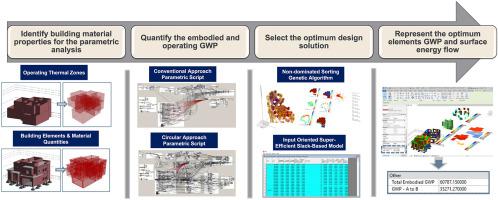Journal of Building Engineering ( IF 6.4 ) Pub Date : 2023-05-28 , DOI: 10.1016/j.jobe.2023.106898 Nada Mowafy , Mohamed El Zayat , Mohamed Marzouk

|
The construction sector is liable for a sizable amount of CO2 emissions and waste. Life Cycle Assessment (LCA) is considered one of the crucial tools that aids in evaluating the impacts of construction emissions. This research aims to quantify the life cycle impacts of the initial and recurrent embodied emissions, operating and reuse/disposal emissions, and utilizing Building Information Modeling (BIM) for a more holistic life cycle approach. The research proposes a parametric BIM-based LCA framework for quantifying the environmental impacts and evaluating the effects of material selection for both embodied and operating emissions. In addition, it considers the different reuse scenarios and percentages and their effect on both the embodied and operating impacts. The proposed framework consists of five main modules: data acquisition module, operating and embodied emissions module, life cycle assessment module, optimization module, and decision-making module. This parametric assessment can be applied for both the conventional and circular approach impacts. For the decision-making process, the resulting emissions are optimized utilizing the Non-dominated Sorting Genetic Algorithm II (NSGA-II) and evaluated through an LCA and Data Envelopment Analysis (DEA) methodology for the material selection. A case study of a residential villa in Cairo is worked out to illustrate the key features of the proposed framework. This assessment analyzes the building materials’ characteristics and efficiency investigating the external walls, internal walls, floors, roofs, and windows design possibilities, and uses visual programming to control the resulting emissions for a more flexible approach. By comparing the integrated LCA and DEA models three optimum design solutions, the conventional approach develops design solutions of higher embodied Global Warming Potential (GWP) than the circular approach. However, it develops lower operating GWP with better applied U-values. The circularity approach employment has reduced the efficiency of the operating GWP due to utilizing materials with high heat transmittance ability.
中文翻译:

基于参数化 BIM 的生命周期评估框架,用于优化可持续设计
建筑行业对大量的 CO 2负有责任排放物和废物。生命周期评估 (LCA) 被认为是有助于评估建筑排放影响的重要工具之一。本研究旨在量化初始和经常性隐含排放、运营和再利用/处置排放的生命周期影响,并利用建筑信息模型 (BIM) 获得更全面的生命周期方法。该研究提出了一个基于 BIM 的参数化 LCA 框架,用于量化环境影响并评估材料选择对隐含排放和运营排放的影响。此外,它还考虑了不同的重用场景和百分比及其对具体影响和运营影响的影响。拟议的框架由五个主要模块组成:数据采集模块、运行和隐含排放模块、生命周期评估模块、优化模块和决策模块。此参数评估可应用于常规方法和循环方法的影响。对于决策过程,使用非支配排序遗传算法 II (NSGA-II) 优化产生的排放,并通过材料选择的 LCA 和数据包络分析 (DEA) 方法进行评估。对开罗的住宅别墅进行了案例研究,以说明所提出框架的主要特征。该评估分析了建筑材料的特性和效率,调查了外墙、内墙、地板、屋顶和窗户的设计可能性,并使用可视化编程来控制由此产生的排放,以采用更灵活的方法。通过比较集成 LCA 和 DEA 模型的三种最佳设计方案,传统方法开发出比循环方法具有更高具体全球变暖潜能值 (GWP) 的设计方案。然而,它开发了具有更好应用 U 值的较低运行 GWP。由于使用具有高传热能力的材料,循环方法的使用降低了运行 GWP 的效率。


























 京公网安备 11010802027423号
京公网安备 11010802027423号